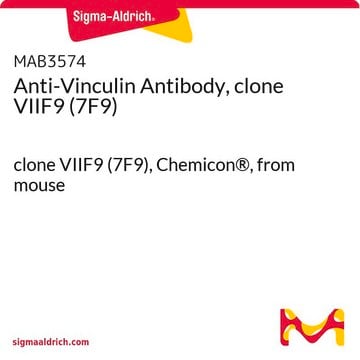Kluczowe dokumenty
SAB4200729
Anti-Vinculin Antibody
mouse monoclonal, VIN-11-5
Synonim(y):
Anti-MV, Anti-Metavinculin, Anti-VINC1
Wybierz wielkość
2040,00 zł
Wybierz wielkość
About This Item
2040,00 zł
Polecane produkty
Nazwa produktu
Anti-Vinculin antibody, Mouse monoclonal, clone VIN-11-5, purified from hybridoma cell culture
pochodzenie biologiczne
mouse
Poziom jakości
forma przeciwciała
purified from hybridoma cell culture
rodzaj przeciwciała
primary antibodies
klon
VIN-11-5, monoclonal
Formularz
buffered aqueous solution
masa cząsteczkowa
~120 kDa
reaktywność gatunkowa
human, monkey, rat, mouse, guinea pig, bovine, hamster, chicken, dog
stężenie
~1.0 mg/mL
metody
immunoblotting: 0.125-0.25 μg/mL using mouse myoblast C2C12 cell extract
immunofluorescence: 5-10 μg/mL
immunohistochemistry: suitable
immunoprecipitation (IP): suitable
izotyp
IgG1
numer dostępu UniProt
Warunki transportu
dry ice
temp. przechowywania
−20°C
docelowa modyfikacja potranslacyjna
unmodified
informacje o genach
mouse ... Vcl(22330)
Opis ogólny
Immunogen
Zastosowanie
Działania biochem./fizjol.
Postać fizyczna
Oświadczenie o zrzeczeniu się odpowiedzialności
Nie możesz znaleźć właściwego produktu?
Wypróbuj nasz Narzędzie selektora produktów.
polecane
Kod klasy składowania
12 - Non Combustible Liquids
Klasa zagrożenia wodnego (WGK)
WGK 1
Temperatura zapłonu (°F)
Not applicable
Temperatura zapłonu (°C)
Not applicable
Wybierz jedną z najnowszych wersji:
Certyfikaty analizy (CoA)
Nie widzisz odpowiedniej wersji?
Jeśli potrzebujesz konkretnej wersji, możesz wyszukać konkretny certyfikat według numeru partii lub serii.
Masz już ten produkt?
Dokumenty związane z niedawno zakupionymi produktami zostały zamieszczone w Bibliotece dokumentów.
Active Filters
Nasz zespół naukowców ma doświadczenie we wszystkich obszarach badań, w tym w naukach przyrodniczych, materiałoznawstwie, syntezie chemicznej, chromatografii, analityce i wielu innych dziedzinach.
Skontaktuj się z zespołem ds. pomocy technicznej








